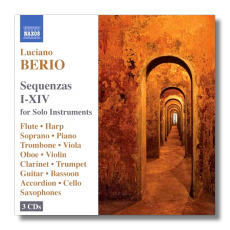
The Internet's Premier Classical Music Source
Related Links
- Berio Reviews
- Latest Reviews
- More Reviews
-
By Composer
-
Collections
DVD & Blu-ray
Books
Concert Reviews
Articles/Interviews
Software
Audio
Search Amazon
Recommended Links
Site News
 CD Review
CD Review
Luciano Berio

Sequenzas I – XIV
- Sequenza I for Flute (1958) - Nora Shulman, flute
- Sequenza II for Harp (1963) - Erica Goodman, harp
- Sequenza III for Female Voice (1966) - Tony Arnold, soprano
- Sequenza IV for Piano (1966) - Boris Berman, piano
- Sequenza V for Trombone (1966) - Alain Trudel, trombone
- Sequenza VI for Viola (1967) - Steven Dann, viola
- Sequenza VII for Oboe (1969) - Matej Sarc, oboe
- Sequenza VIII for Violin (1976) - Jasper Wood, violin
- Sequenza IX for Clarinet (1980) - Joaquín Valdepeñas, clarinet
- Sequenza X for Trumpet and "silent" Piano (1984) - Guy Few, trumpet
- Sequenza XI for Guitar (1988) - Pablo Sáinz Villegas, guitar
- Sequenza XII for Bassoon (1995) - Kenneth Munday, bassoon
- Sequenza XIII for Accordion (1995) - Joseph Petric, accordion
- Sequenza XIV for Cello (2002) - Darrett Adkins, cello
- Sequenza VIIb for Soprano Saxophone (1995) - Wallace Halladay, soprano saxophone
- Sequenza IXb for Alto Saxophone (1981) - Wallace Halladay, alto saxophone
Naxos 8.557661-63 3CDs: 63:02, 60:09, 58:48
Luciano Berio wrote his Sequenzas, a series of solo works, between 1958 and 2002 with the talents of particular performers in mind. By necessity, these performers were some of modern music's best friends. For example, Sequenza VIIa was composed for oboist Heinz Holliger, and Sequenza III was composed for Berio's erstwhile wife, the mezzo-soprano Cathy Berberian. Each Sequenza is a kind of demonstration of nearly superhuman virtuosity and of extended playing techniques – an attempt to show what each musician and each instrument is capable of, within the framework of the 20th-century avant garde. They weren't intended as a cycle, per se, and so while individual ones have been recorded from time to time, there's been no attempt to record them as a group until recently. In 1999, Deutsche Grammophon's 20/21 series presented them as a "complete" set in performances by the Ensemble InterContemporain.That collection won many kudos, but in 2002, Berio completed his Sequenza XIV for cello, and so the 20/21 release was no longer complete. In the past few months, two other labels – Mode and Naxos - have come out with their own complete Sequenzas, including Sequenza XIV. (As Berio died in 2003, it's unlikely that he has any surprises in store for Mode or Naxos!) The Mode collection actually extends to four CDs (for the price of three), as it includes other works for solo instruments.
Naxos' collection doesn't contain some of the "big names" that Mode's does (cellist Rohan de Saram, pianist Aki Takihashi, etc.), but it does include pianist Boris Berman, and many important and accomplished musicians from Canada. As always, the Naxos discs are about half the price of the other two collections. The most interesting comparisons, I think, should not be among the three collections, but between today's performers and the original dedicatees, whenever possible. For example, it's gratifying to hear how close Tony Arnold comes to Cathy Berberian in Sequenza III, a fantasia of whoops, yips, and mutterings based on a brief text by Markus Kutter. (I always half-suspected that Cathy was just making it up as she went along, but now I know better!) The recordings were made between 1998 and 2004, all in the St. John Chrysostom Church in Newmarket, Ontario, so the sonic perspective is consistent.
Of course this collection is important as a reference. Most people don't read the encyclopedia from cover to cover, but there's nothing invalid about doing so, and Naxos' recordings should gratify listeners whether they prefer to wade or to jump right in. Certainly this is not easy music, but it's never tiresome, and like Bach's Well-Tempered Clavier (!), I find it rewarding to live with, both as a "gee whiz" experience and as an artistically valid statement. Thanks to Naxos for making even Berio more approachable!
Copyright © 2006, Raymond Tuttle




















